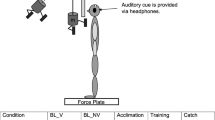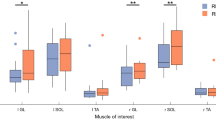Abstract
Anticipatory postural adjustments (APAs) represent the feedforward mechanism of neuromuscular control essential for maintaining balance under predictable perturbations. The importance of vision as a distal sensory modality in the generation of APAs is well established. However, the capabilities of external cues in generating APAs are less explored. In the present study, vibratory cue was investigated for its reliability among healthy individuals in generating anticipatory response under external perturbation in the absence of vision. Ten participants, in quiet stance, were provided with external perturbation in the form of pendulum impact in anterior–posterior (AP) direction under conditions of: both vision and vibratory cue absent; vision present but vibratory cue was absent; vision and vibratory cue both were present; only vibratory cue is present with vision being absent. EMG activities of the leg muscles and displacement of center of pressure (COP) in AP direction were recorded. The data were later analyzed and quantified in the time frame of anticipatory and compensatory phases. The results showed that with training, participants were able to generate significant APAs relying on the vibratory cue alone. Improvement in APAs was accompanied by minimizing the need for larger CPA and improved stability (COP displacement) under perturbation. The study outcome indicates the possibility of using vibratory cues for APA-based interventions.






Similar content being viewed by others
References
Alahakone AU, Senanayake SMNA (2010) A real-time system with assistive feedback for postural control in rehabilitation. IEEE/ASME Trans Mechatron 15:226–233. https://doi.org/10.1109/TMECH.2010.2041030
Aruin AS, Latash ML (1995) Directional specificity of postural muscles in feed-forward postural reactions during fast voluntary arm movements. Exp Brain Res 103:323–332. https://doi.org/10.1007/BF00231718
Aruin AS, Kanekar N, Lee YJ, Ganesan M (2015) Enhancement of anticipatory postural adjustments in older adults as a result of a single session of ball throwing exercise. Exp Brain Res 233:649–655. https://doi.org/10.1007/s00221-014-4144-1
Bair WN, Barela JA, Whitall J et al (2011) Children with developmental coordination disorder benefit from using vision in combination with touch information for quiet standing. Gait Posture 34:183–190. https://doi.org/10.1016/j.gaitpost.2011.04.007
Bartlett HL, Ting LH, Bingham JT (2014) Accuracy of force and center of pressure measures of the Wii Balance Board. Gait Posture 39:224–228. https://doi.org/10.1016/j.gaitpost.2013.07.010
Bastian AJ (2006) Learning to predict the future: the cerebellum adapts feedforward movement control. Curr Opin Neurobiol 16:645–649. https://doi.org/10.1016/j.conb.2006.08.016
Brunetti O, Filippi GM, Lorenzini M et al (2006) Improvement of posture stability by vibratory stimulation following anterior cruciate ligament reconstruction. Knee Surg Sports Traumatol Arthrosc 14:1180–1187. https://doi.org/10.1007/s00167-006-0101-2
Chen B, Lee YJ, Aruin AS (2018) Standing on a sliding board affects generation of anticipatory and compensatory postural adjustments. J Electromyogr Kinesiol 38:168–174. https://doi.org/10.1016/j.jelekin.2017.12.008
Chiari L, Dozza M, Cappello A et al (2005) Audio-biofeedback for balance improvement: an accelerometry-based system. IEEE Trans Biomed Eng 52:2108–2111. https://doi.org/10.1109/TBME.2005.857673
Collins JJ, Priplata AA, Gravelle DC et al (2003) Noise-enhanced human sensorimotor function. IEEE Eng Med Biol Mag 22:76–83. https://doi.org/10.1109/MEMB.2003.1195700
De Azevedo AKEC, Claudino R, Conceição JS et al (2016) Anticipatory and compensatory postural adjustments in response to external lateral shoulder perturbations in subjects with Parkinson’s disease. PLoS ONE 11:1–17. https://doi.org/10.1371/journal.pone.0155012
Dozza M, Horak FB, Chiari L (2007) Auditory biofeedback substitutes for loss of sensory information in maintaining stance. Exp Brain Res 178:37–48. https://doi.org/10.1007/s00221-006-0709-y
Friedli WG, Cohen L, Hallett M et al (1984) Postural adjustments associated with rapid voluntary arm movements. 1. Electromyographic data. J Neurol Neurosurg Psychiatry 47:611–622. https://doi.org/10.1136/jnnp.51.2.232
Goodworth AD, Wall C, Peterka RJ (2009) Influence of feedback parameters on performance of a vibrotactile balance prosthesis. IEEE Trans Neural Syst Rehabil Eng 17:397–408. https://doi.org/10.1109/TNSRE.2009.2023309
Goodworth AD, Wall C, Peterka RJ (2011) A balance control model predicts how vestibular loss subjects benefit from a vibrotactile balance prosthesis. In: Proceedings of the annual international conference of the IEEE engineering in medicine and biology society, EMBS. Boston, Massachusetts USA, pp 1306–1309
Horak FB, Nashner LM (1986) Central programming of postural movements: adaptation to altered support-surface configurations. J Neurophysiol 55:1369–1381. https://doi.org/10.1152/jn.1986.55.6.1369
Kanekar N, Santos MJ, Aruin AS (2008) Anticipatory postural control following fatigue of postural and focal muscles. Clin Neurophysiol 119:2304–2313. https://doi.org/10.1016/j.clinph.2008.06.015
Kim SW, Shim JK, Zatsiorsky VM, Latash ML (2006) Anticipatory adjustments of multi-finger synergies in preparation for self-triggered perturbations. Exp Brain Res 174:604–612. https://doi.org/10.1007/s00221-006-0505-8
Krishnan V, Aruin AS (2011) Postural control in response to a perturbation: role of vision and additional support. Exp Brain Res 212:385–397. https://doi.org/10.1007/s00221-011-2738-4
Labanca L, Iovine R, Bragonzoni L et al (2020) Instrumented platforms for balance and proprioceptive assessment in patients with total knee replacement: a systematic review and meta-analysis. Gait Posture 81:230–240. https://doi.org/10.1016/j.gaitpost.2020.07.080
Lacquaniti F, Maioli C (1987) Anticipatory and reflex coactivation of antagonist muscles in catching. Brain Res 406:373–378
Lee PY, Gadareh K, Naushahi MJ et al (2013) Protective stepping response in Parkinsonian patients and the effect of vibrotactile feedback. Mov Disord 28:482–489. https://doi.org/10.1002/mds.25227
Liang H, Kaewmanee T, Aruin AS (2020) The role of an auditory cue in generating anticipatory postural adjustments in response to an external perturbation. Exp Brain Res 238:631–641. https://doi.org/10.1007/s00221-020-05738-6
Mauk MD, Medina JF, Nores WL, Ohyama T (2000) Cerebellar function: coordination, learning or timing? Curr Biol 10:522–525. https://doi.org/10.1016/S0960-9822(00)00584-4
Miller J (1967) Vision, a component of locomotion. Physiotherapy 53:326–332
Mohapatra S, Krishnan V, Aruin AS (2012) The effect of decreased visual acuity on control of posture. Clin Neurophysiol 123:173–182. https://doi.org/10.1016/j.clinph.2011.06.008
Nardone A, Tarantola J, Giordano A, Schieppati M (1997) Fatigue effects on body balance. Electroencephalogr Clin Neurophysiol Electromyogr Motor Control 105:309–320. https://doi.org/10.1016/S0924-980X(97)00040-4
Osoba MY, Rao AK, Agrawal SK, Lalwani AK (2019) Balance and gait in the elderly: a contemporary review. Laryngosc Investig Otolaryngol 4:143–153. https://doi.org/10.1002/lio2.252
Pasma JH, Engelhart D, Schouten AC et al (2014) Impaired standing balance: the clinical need for closing the loop. Neuroscience 267:157–165. https://doi.org/10.1016/j.neuroscience.2014.02.030
Paulus WM, Straube A, Brandt T (1984) Visual stabilization of posture: physiological stimulus characteristics and clinical aspects. Brain 107:1143–1163. https://doi.org/10.1093/brain/107.4.1143
Phinyomark A, Limsakul C, Phukpattaranont P (2011) Application of wavelet analysis in EMG feature extraction for pattern classification. Meas Sci Rev 11:45–52. https://doi.org/10.2478/v10048-011-0009-y
Rasman BG, Forbes PA, Tisserand R, Blouin JS (2018) Sensorimotor manipulations of the balance control loop-beyond imposed external perturbations. Front Neurol 9:1–17. https://doi.org/10.3389/fneur.2018.00899
Santos MJ, Kanekar N, Aruin AS (2010a) The role of anticipatory postural adjustments in compensatory control of posture: 2. Biomechanical analysis. J Electromyogr Kinesiol 20:398–405. https://doi.org/10.1016/j.jelekin.2010.01.002
Santos MJ, Kanekar N, Aruin AS (2010b) The role of anticipatory postural adjustments in compensatory control of posture: 1. Electromyographic analysis. J Electromyogr Kinesiol 20:388–397. https://doi.org/10.1016/j.jelekin.2009.06.006
Sienko KH, Seidler RD, Carender WJ et al (2018) Potential mechanisms of sensory augmentation systems on human balance control. Front Neurol 9:1–11. https://doi.org/10.3389/fneur.2018.00944
Siriphorn A, Chamonchant D, Boonyong S (2015) The effects of vision on sit-to-stand movement. J Phys Ther Sci 27:83–86. https://doi.org/10.1589/jpts.27.83
Solnik S, Rider P, Steinweg K et al (2010) Teager-Kaiser energy operator signal conditioning improves EMG onset detection. Eur J Appl Physiol 110:489–498. https://doi.org/10.1007/s00421-010-1521-8
Sozzi S, Nardone A, Schieppati M (2019) Vision does not necessarily stabilize the head in space during continuous postural perturbations. Front Neurol 10:1–13. https://doi.org/10.3389/fneur.2019.00748
Wall C, Kentala E (2005) Control of sway using vibrotactile feedback of body tilt in patients with moderate and severe postural control deficits. J Vestib Res 15:313–325
Wolpert DM, Ghahramani Z, Jordan MI (1995) An internal model for sensorimotor integration. Science 269:1880–1882
Acknowledgements
This work was conducted with the facility built using the support from corresponding author’s Institute, DST, SERB, and MHRD Research Award.
Author information
Authors and Affiliations
Contributions
SB: methodology, software, validation, investigation, formal analysis, data curation, visualization, and writing—original draft preparation. VN: conceptualization, investigation, and formal analysis. VV: supervision, methodology, and writing—reviewing and editing.
Corresponding author
Ethics declarations
Conflict of interest
The authors declare that they have no competing interest.
Availability of data and material
Not applicable.
Code availability
Not applicable.
Ethics approval
The study was approved by the Institute Ethics Committee under the approval number IEC/VV/2021/013.
Consent to participate
All the participants gave written informed consent after a complete explanation of this study. This study was approved by the Institute Ethics Committee.
Consent for publication
All the participants gave written informed consent for publication after a complete explanation of this study.
Additional information
Communicated by Francesco Lacquaniti.
Publisher's Note
Springer Nature remains neutral with regard to jurisdictional claims in published maps and institutional affiliations.
Rights and permissions
About this article
Cite this article
Bhardwaj, S., Negi, V. & Vashista, V. Vibratory cue training elicits anticipatory postural responses to an external perturbation. Exp Brain Res 240, 1105–1116 (2022). https://doi.org/10.1007/s00221-022-06313-x
Received:
Accepted:
Published:
Issue Date:
DOI: https://doi.org/10.1007/s00221-022-06313-x




